Invented by Susan S. Whaley
Medication Compliance Systems are designed to help patients take their medications correctly and on time. These systems utilize various technologies, such as smart pill bottles, medication reminder apps, and electronic monitoring devices, to ensure that patients adhere to their prescribed medication regimens. The market for these systems is driven by the increasing prevalence of chronic diseases, the aging population, and the growing demand for personalized healthcare solutions.
One of the key factors driving the market growth is the rising number of chronic diseases, such as diabetes, hypertension, and cardiovascular diseases. These conditions often require long-term medication regimens, and non-adherence can have serious consequences. Medication Compliance Systems provide patients with reminders and alerts to take their medications, helping them manage their conditions effectively and prevent complications.
Additionally, the aging population is another significant driver of the market for Medication Compliance Systems. As people age, they are more likely to develop chronic diseases and require multiple medications. However, older adults often face challenges in managing their medications, such as memory loss, vision problems, and physical limitations. Medication Compliance Systems offer solutions tailored to the needs of older adults, including easy-to-use interfaces, large font sizes, and audible reminders.
Furthermore, the demand for personalized healthcare solutions is fueling the growth of the market. Medication Compliance Systems can be customized to meet the specific needs of individual patients. For example, some systems can track medication adherence in real-time and send alerts to healthcare providers or caregivers if a patient misses a dose. This allows for timely interventions and adjustments to the treatment plan, improving patient outcomes and reducing healthcare costs.
The market for Medication Compliance Systems is highly competitive, with numerous players offering a wide range of products and services. Some companies focus on developing innovative technologies, such as smart pill bottles with built-in sensors that detect when a medication is taken. Others provide comprehensive medication management platforms that integrate with electronic health records and pharmacy systems.
In conclusion, the market for Medication Compliance Systems is experiencing significant growth due to the increasing prevalence of chronic diseases, the aging population, and the demand for personalized healthcare solutions. These systems play a crucial role in improving medication adherence, enhancing patient outcomes, and reducing healthcare costs. As the importance of medication compliance continues to gain recognition, the market for these systems is expected to expand further, offering new opportunities for innovation and improvement in patient care.
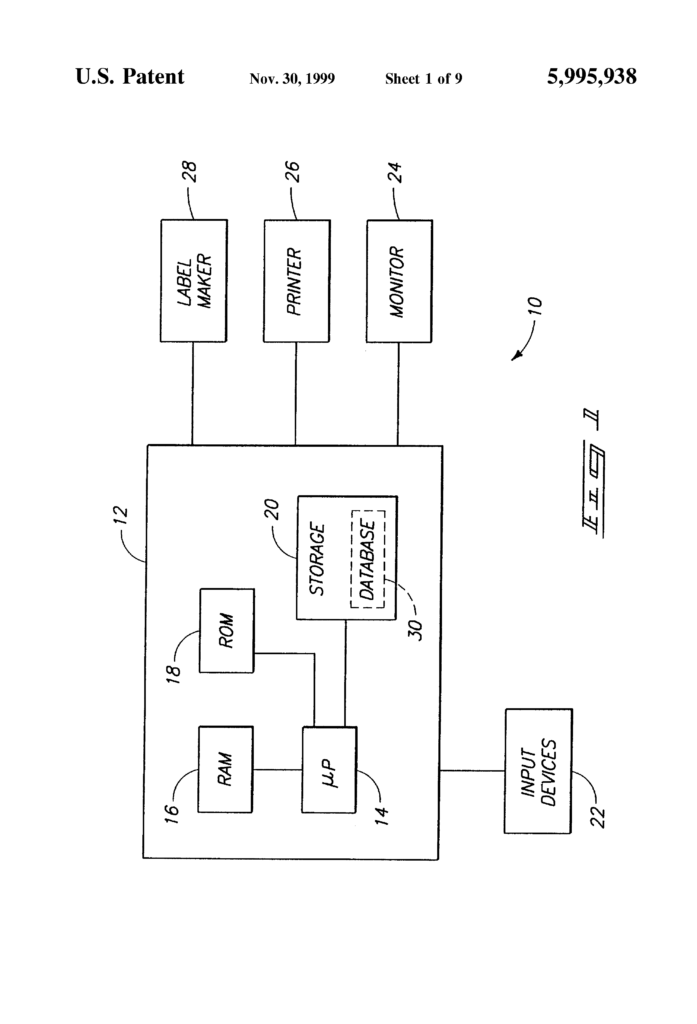
The Susan S. Whaley invention works as follows
The system includes an output device, a computer that is in communication with it and has a program loaded on it to define a specific logic circuit, which creates a graphic user interface through which the user can indicate the number times the drug is to taken each day. This causes the output to print a label with data identifying the drug and with a shape representing the number or time of the day when the drug is to take.
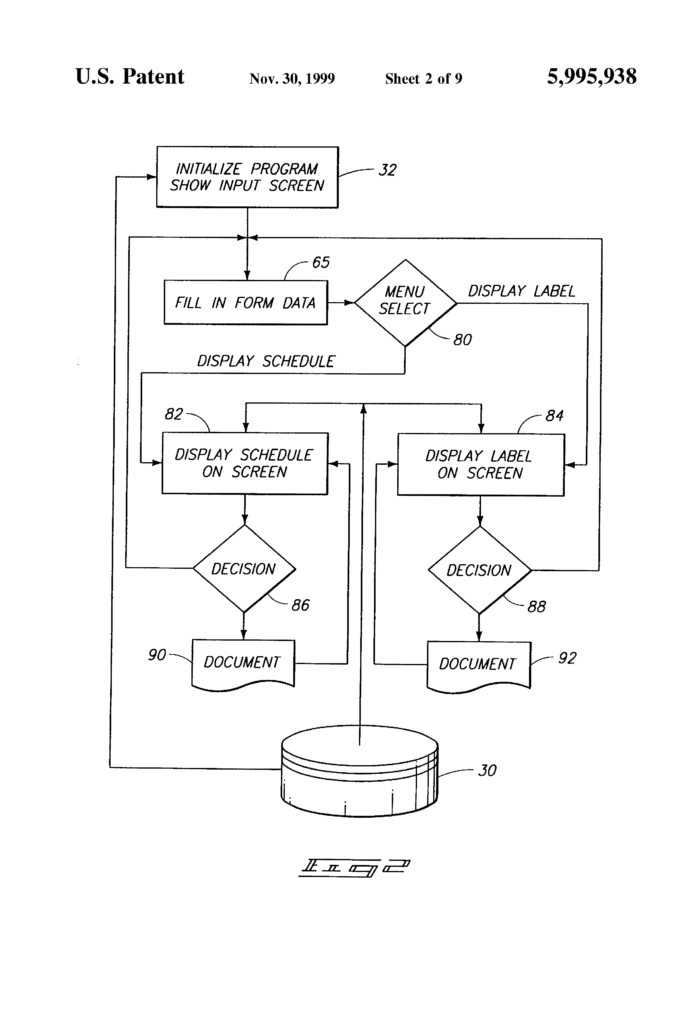
Background for Medication Compliance System
People are living longer because of advances in medicine and high-powered drugs. The elderly and chronically ill face a major challenge in managing multiple medications. The number of medicines taken and the timing of the medication are serious health issues. Drug contraindications are the reason for admission of 40% of patients in hospital. This contributes both to increased health care costs and to a lower effectiveness of drugs.
The multiple medications, despite the fact that pharmaceutical improvements have made it possible to use fewer drugs on a daily base for the duration or treatment, can be confusing for patients. Multiple medications can also lead to visual impairments that make it difficult for some patients to understand the instructions.
When there are any changes to the treatment, “”Homemade’ systems can be cumbersome. Plastic box dispensers can also be limiting. The compartments are too small to accommodate many medications, and the drugs must be in pill form to fit. They also do not protect sensitive medicines from light or air. Plastic boxes are not suitable for inhalants or patches. They also do not work well with salves, syrups, or salves.
A federal law requires that patients receive printed information about side effects and warnings at the time they fill a prescription.
The invention is a medication compliance device that consists of an output device as well as a computer which communicates with the output and has a program on it to define a logic circuit. This creates a graphical interface where a user can indicate the number times they want to take a pharmaceutical during the day. It also causes the output to print a label with data identifying the pharmaceutical and with a shape representing how many times per day the pharmaceutical should be taken.
An aspect of the invention is a system that produces visual aids for patients who take multiple medicines. The invention addresses both the timing and number of medications that are taken each day. In one embodiment visual aids can be prepared by a pharmacist when a prescription has been filled and dispensed.
This disclosure of the invention was submitted to further the constitutional purpose of the U.S. Patent Laws “to promote the advancement of science and useful art” (Article 1 Section 8).
FIG. The system 10 of FIG. 1 is a computerized device that embodies the invention. The system 10 includes a computer 12. This computer 12 can be a minicomputer or microcomputer or a UNIX machine or mainframe computer. It could also be a PC such as an Intel 286, 386 or 486, Pentium or higher or a clone of it, or Apple, Macintosh or PowerPC or other suitable computers. In a preferred embodiment, computer 12 is a computer. The computer 12 contains typical components, such as a memory or storage 20, a microprocessor 14 and RAM 16 communicating with it. hard drive, disk drive, tape unit, CD-ROM, etc. Serial ports (not pictured) and parallel ports are not pictured. Memory is meant to include storage media like hard drives, optical disks and backup tapes. It also includes network drives, flash drives, CD-ROM disks etc. As well as hardware that reads from and writes onto the storage media. The system 10 also includes input devices (e.g. The system 10 further includes input devices 22 (e.g. Monitor 24, printer 26, label maker 28, and label maker 28. In one embodiment, labels are printed using the printer 26, and the label maker is not used. The storage 20 contains a database 30, which will be explained in more detail below, and software for printing charts and labels.
In step 32 (FIG. In step 32 (FIG. 3. Using the monitor 24, for example. The interface contains a form with various fields that are filled out by the user. For example, a pharmacist. The form is linked to the database 30 as explained below.
The interface 34 has a field 36 where a prescription number can be automatically entered. Each new prescription is filled by the system, and this number is increased. In one embodiment, it doesn’t matter if the prescription is for a new or repeat patient. In one embodiment, when a patient brings in a new prescription, the prescription number for that patient is changed. The interface 34 also includes a field in which the user can enter data that identifies the client (or the patient). Field 38 data is usually the client’s name, but it can also be a number, such as the patient number or the social security number. The interface 34 also provides a field in which to enter the name of the client?s doctor.
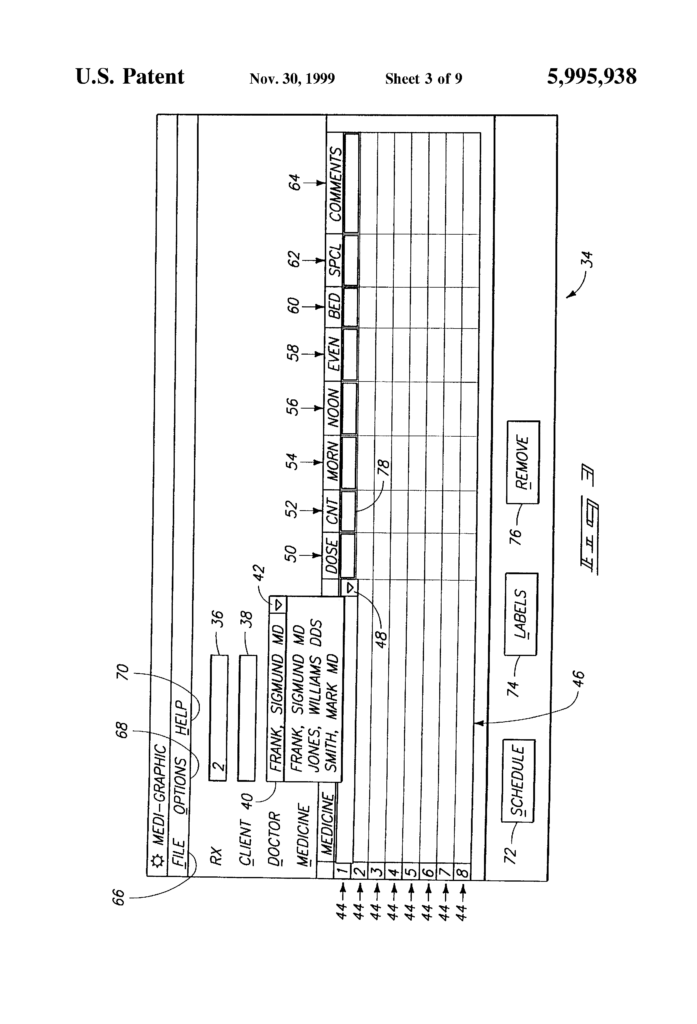
The field 40 in the illustrated embodiment is a pull-down type and has a button 42 that, when pressed causes a menu appear. The database 30 contains the names of many doctors. By clicking or pushing a pull-down button 42 and selecting a physician from the list that appears, the user is able to select the doctor they want. The user does not have to remember the exact spelling of doctor names and do not need type data into this field. The database 30 in one embodiment is a Microsoft Access database. In one embodiment, a computer 12 can be reconfigured so that it uses a different Access database for the list of doctors. To change the database, for example, the Windows initialization file (.ini) in the subdirectory that contains the software can be modified to read: “
[Medigraf]
DocPath=c:\\mydbdir\\mydoctor.mdb
DocTable=TheDoctor
DocName=Name
DocIndex=Index.
This assumes that Medigraf is the name of the software, that the user’s directory is named mydbdir on the C-drive of the computer 12, and that a Microsoft Access database named mydoctor.mdb is located in that directory. The table TheDoctor in that database contains two fields, Name and Index. The Name field contains the names for the doctors and the Index field contains a unique long number that is assigned to each row of the database.
In the embodiment shown, “the interface 34” also includes a plurality rows 44. Each row 44 has a field 46 where the user can enter the type of medicine. The field 46 in the illustrated embodiment is a pull-down type and includes a button that, when pressed by the user, displays a menu. The database 30 contains the names of several types of pharmaceuticals. By clicking or pushing a pull-down button 48 and selecting one of these pharmaceuticals from the list that appears, the user is able to select the type of pharmaceutical. The user does not have to remember the exact spelling of the names of pharmaceuticals and do not need type data into this field. The user fills in the data for the first row 44. After that, they move down to row 48, where the pull-down menu button 48 is moved to the next row. This allows the user to select the next pharmaceutical using the pull-down menu. Computer 12 can be reconfigured so that a different Access database is used to display the list of pharmaceuticals.
The rows 44 each include a field in which the user enters a dosage for the drug in the same row. The rows 44 also include a field 50 in which the user enters a dose for the pharmaceutical. The rows 44 also include fields 54 to 62 where the user can designate when the pharmaceutical should be taken. The interface 34 has a number of fields, including a 54 that is used to indicate that the pharmaceutical should be taken early in the morning. A 56 is selected for the afternoon, and 60 is selected at bedtime. In one embodiment, clicking in a field 56, 58 or 60 will fill that field with a “1”. By clicking in the field again, the “1” becomes a “1-2.” By clicking in the field again, the “1-2″ becomes a”2.” Other options are possible and different options can be presented for each field. Each row 44 includes a field 64 where comments about the pharmaceuticals in that row may be entered by the user.
In step 65 (FIG. 2).
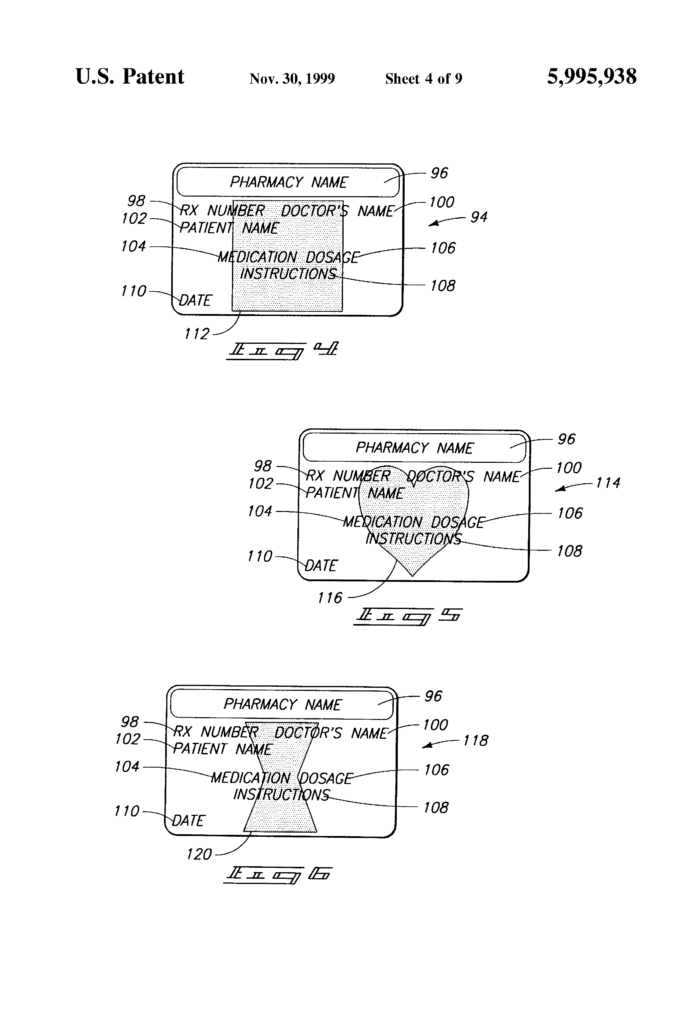
Many alternative interfaces are available. Pull-down menus can be added to any field of the interface 34. The organization can also be done by column instead of row, or by other suitable methods.
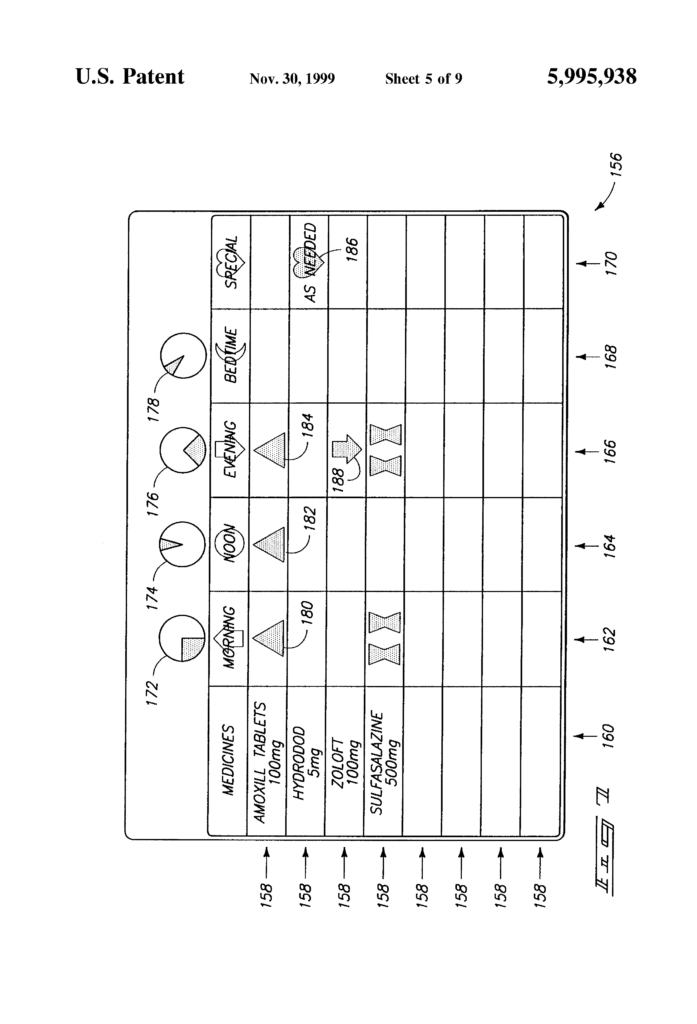
Click here to view the patent on Google Patents.
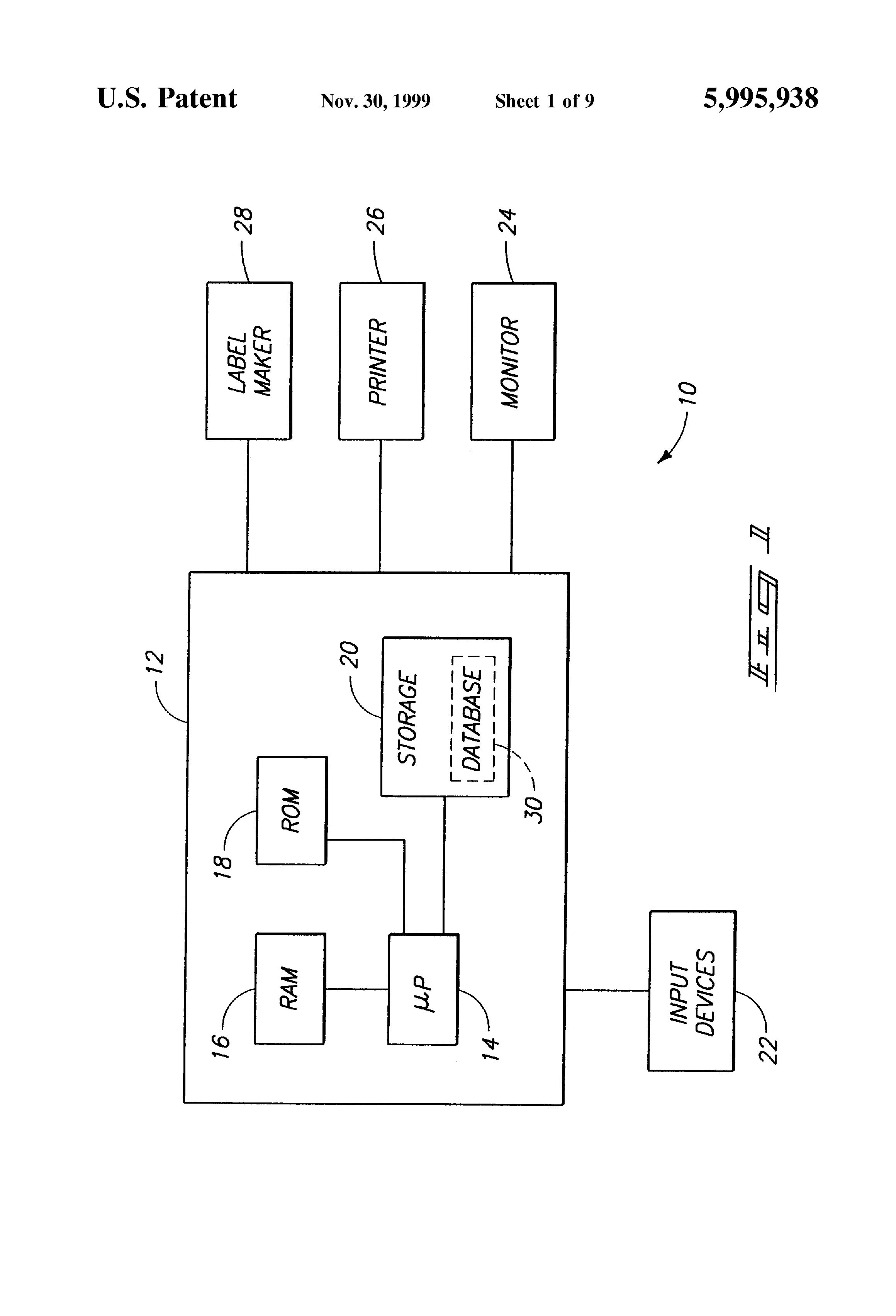
Leave a Reply